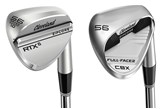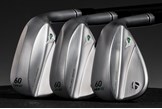Want to get up and down more often? Here’s how to choose the best golf wedge for your game
Published: Last updated:
All golfers miss greens, which makes choosing the best golf wedges for your game a key part of lowering your scores. This guide to choosing the right type of wedge will make sure your wedges are just what you need.
We have all been there, hunting for the best golf wedges for our game, spending hours confusing ourselves on what to buy. It is an important decision as wedges are a huge part of our golf bags and can either be the most loved or most hated clubs in the bag. This may be due to how often we use them. On the fringe, in the rough, or buried in the sand, our wedges are what get us out of trouble.
For those who struggle around the green, having the right technique is essential, but also having the right equipment for the job is key. Being able to select the correct wedge for the shot you want to play is crucial. Each wedge is designed for a specific occasion on the course, from a tight lie, opening the face, in the sand, and so on. My point is having the right club for the shots you like to play is something you must get right.
The world of golf clubs is confusing enough without having to decipher exactly what each loft, grind, and bounce means on every wedge. Don’t worry, I’m here to help! What should you focus on when picking a wedge to suit your swing and get your short game in the groove?

Types of wedge
Pitching Wedge (PW)
The most common and arguably the most used wedge in the bag. The pitching wedge is usually lofted between 44° and 48° degrees and is ideal for full shots and lower-trajectory pitch shots into greens. The PW is often included in a set of irons and will hit the ball further than the other wedges due to its loft being lower. Most modern sets have stronger lofts and, as a result, the pitching wedge is often lower lofted to suit. This usually leaves a gap perfect for the appropriately named gap wedge.
Gap Wedge (GW)
Slightly more lofted than the pitching wedge, as the name suggests, the gap wedge is there to fill the ‘gap’ between the pitching wedge and sand wedge. It tends to be seen in the lofts of 50° and 52° degrees and is typically suited for fuller shots, but it’s also great for an array of pitches around the green. You may find that this club is also referred to as an attack wedge (AW) or utility wedge (UW) when included in a set of irons.
Sand Wedge (SW)
It may sound silly to say but as the name suggests this club is mainly used for bunker play in and around the green due to its higher loft and bounce. The sand wedge can be used for full shots from the fairway too but you’ll find it is more popular in the bunker or around the green. You will see it lofted at 54° and 56° degrees and it also has a heavier and wider head design to help escape the sand.
Lob Wedge (LW)
The lob wedge has risen in popularity recently. The ideal tool for throwing the ball up high over a short distance, famously mastered by multiple major champion Phil Mickelson. The lob wedge is rarely a club you will use for full shots but it comes into its own when chipping, playing out of sand, or hitting flop shots. You can get a lob wedge in 58° to 64°, ideal for golfers who love to take on the high-risk shots over a bunker.

How do I get the correct lofts and gapping?
All golf clubs have a loft and understanding these lofts can help you pick the correct wedges for your set. Every golfer will have a certain loft on their driver and it’s easy to understand as it’s stamped on the head of the club. However with your irons that is rarely the case. Modern iron sets can have lofts that differ greatly, a 7 iron for example can range from 26° all the way to 35°, which is a variation of 9°! So understanding what loft you have will help greatly when picking between lofts on wedges.
With pitching wedge lofts typically sitting in the mid to low 40s it’s important to understand your lowest iron’s loft. If you updated your irons not too long ago then unaware to you, it may have created a substantial gap in your clubs, which can mean a big difference in yardage. The ideal gap between clubs would be 4°, potentially up to 6° at a push.
How many wedges should I have?
Most golfers will carry between two and four wedges. Four wedges in the bag gives you more options when it comes to shots into and around the green, but not every golfer necessarily needs four wedges. Three wedges is quite a common option and leaves extra room for a fairway wood or hybrid at the top of the bag.
The most important thing for you to do is decide where you require the extra clubs. Look at where you have the biggest gaps, is it at the top or bottom end of the bag? Often golfers will not need more than three wedges and they’re a much easier club to sacrifice than a club which will help you hit the ball further like a hybrid.

Cavity vs blade wedges
The terms ‘cavity back’ and ‘blade’ refer to the shape and design of the clubhead. The designs offer distinctly different characteristics that impact the performance of golfers at varying skill levels. Beginners and high handicappers may benefit from the more forgiving and easier-to-use cavity back in comparison the the more advanced player wanting the precision and workability of a blade.
It’s not always about skill level though. If you play golf at a course that has firm and fast greens you may prefer to go with the blade which is better for controlling spin. Golfers may also opt for the best of both worlds, having low-lofted cavity back wedges and high-lofted bladed wedges to balance forgiveness and precision.
Cavity back wedge
The hollowed-out head design allows for the weight to be distributed around the head which in turn boosts forgiveness on strikes not out the middle of the club.
The high forgiveness of the cavity back means it will be less punishing on mishits, making it a good option for mid- and high-handicappers. In turn, helping with accuracy on approaches into the green, and who doesn’t want that?
The launch angle of cavity back wedges are typically higher than blades so as a comparison they do produce slightly less spin rate. You can see from our golf wedges test that the Cleveland CBX lacked spin in comparison to its bladed counterpart. However, it was one of the longest wedges we tested and if you want distance and forgiveness it makes the ideal wedge.
Bladed wedge
With a more traditional look to the head, the blade has a full and solid design. Unlike the cavity which has the weight focused around the perimeter, the blade has all the weight concentrated to the center of the clubface. This promotes more control and precision for those who can find the middle of the face, often more beneficial to the higher-skilled player.
Better golfers will often prioritize precision and control over forgiveness.
The bladed wedge typically has a lower launch angle and a higher spin rate than a cavity back wedge. This plays into the hands of an accomplished golfer who likes to manipulate the trajectory of their ball on approach shots to the green.

What bounce do I need on my wedges?
The bounce of a wedge is something many golfers don’t fully understand, but it’s quite a simple concept. As the name would suggest, it’s the area of the club that helps it bounce off the sand or turf without digging in.
A wedge bounce is the angle between the leading edge and the lowest point of the sole. This is the part of the club which makes contact with the ground. Ensuring that you have the correct bounce and grind combination for your conditions can help optimize your spin, contact, and control.
Arguably the most famous name in wedges, Bob Vokey, said “Bounce is your friend,” it gives you the forgiveness needed to strike the ball properly even on bad shots.
All golfers are presented with an array of different ground conditions at each course they play. For this reason, it makes sense to have as many bounces at your disposal as it does lofts. A collection of different lofts and bounce angles will allow you to play several different shots.
Low Bounce
A low bounce on a wedge is typically between 4°-6°, low bounces are ideal for firmer turf conditions or bunkers with harder sand. A low bounce, high lofted wedge is great for hitting high shots off tight lies (when there is little or no grass underneath the golf ball and the ground is particularly firm).
Mid Bounce
Designed for firm to normal turf conditions, mid-bounce wedges range from 7°-10° and are the most versatile. Ideal for a range of different conditions and swing types the mid-bounce is best for all-round playability.
High Bounce
High-bounce wedges are 10° or above and are great for bunkers, soft turf, and fluffy lies. They can generate a lot of spin and give golfers great levels of control in their short game. Due to the prominent leading edge, these wedges are great for golfers who tend to take deep divots and have a much steeper swing.

Sole grinds
Brands offer a selection of different grinds but most of us don’t have a clue what they are, what they do, or how can they help our game.
The sole grind is the bottom of the club head, it refers to the shaping and profile of the sole. You can see in the image above the TaylorMade MG4 wedge has the same loft but each with a different camber on the sole, this is what is known as the grind.
Wedges are a fine art and the sole grinds show how much thought has gone into how the club interacts with the turf. A certain shape of the sole will allow you to play a certain shot better than another grind available in the same lofted club.
Sole grinds allow a golfer to select the perfect club to suit them, making a wedge ideal for different swings, shot styles, and course conditions. For example, when you take material out of the heel it allows the club to sit lower and more open making it easier to get the ball up in the air.

Finish
When a wedge has completed production it will have a coating or treatment added to the head, this is what’s referred to as the finish. The decision on what finish to choose is mainly personal preference and what suits your eye better.
Be warned, all finishes will wear over time no matter what style you pick. The darker finishes are one of the most popular on the market but over time they can show the worst signs of wear. If you’d like to maintain the color and appearance of your wedges longer, then a chrome or nickel finish would be better.
There is one finish that may help slightly with spin and that is the raw finish. The oxidized club face is likely to create more friction when in contact with the ball. Raw finishes are designed to wear and rust more over time but are certainly a must-avoid if you hate the sight of a rusty clubhead.

How often should you change your wedges?
Changing your wedges is something dependent on a few factors such as how often you play, course condition, groove wear, and your practice habits. Generally, we would recommend golfers look to replace their wedges every 60 to 100 rounds, which for most golfers will give them a two-year life cycle.
Regularly inspecting your wedges for damage and signs of wear along with giving them a good scrub can help the lifetime of a wedge. We would recommend that after 60 rounds or so you should thoroughly inspect your grooves. Ideally, you would test them against a new wedge to see how your spin rate and launch angle have been affected over time.
About the Author

Will Shreeve-Peacock – Golf Equipment Writer
Will is an expert in golf shoes, GPS watches, rangefinders, and training aids.
He has a degree in journalism from Sheffield Hallam University and four years’ experience working in golf retail with American Golf where he was trained by a host of the big-name manufacturers.
A six-handicapper, Will has played golf for more than a decade and is a member at Burghley Park Golf Club in Stamford, Lincolnshire.



